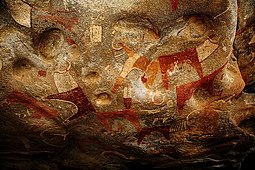Laas Geel
| Laas Geel | |
|---|---|

|
|
| Location | Hargeisa, Somaliland |
| Access | Public |
Laas Geel (Somali: Laas Geel), also spelled Laas Gaal, are cave formations on the rural outskirts of Hargeisa, Somaliland. They contain some of the earliest known cave paintings in the Horn of Africa. Laas Geel's rock art is estimated to date to somewhere between 9,000 and 3,000 years BC.
During November and December 2002, an archaeological survey was carried out in Somaliland by a French team of researchers. The expedition's objective was to search for rock shelters and caves, that contain archaeological sediments and infills in order to document the historical period when production economy appeared in this part of the Horn of Africa (circa 5,000 to 2,000 years BC). During the course of the survey, the excavation team discovered the Laas Geel cave paintings, that encompass an area of ten rock alcoves (caves). In an excellent state of preservation, the rock art depicts wild animals and decorated cattle (cows and bulls). They also feature herders, who are believed to be the creators of the paintings. Laas Geel's rock art is executed in the same distinctive Ethiopian-Arabian style as the Dhambalin and Karinhegane cave paintings that are also situated in Somaliland.
Although the Laas Geel rock art had been known to the area's inhabitants for centuries, its existence only came to international attention after the 2002 discovery. In November 2003, a mission returned to Laas Geel and a team of experts undertook a detailed study of the paintings in their prehistoric context.
Somaliland in general is home to numerous such archaeological sites and megalithic structures, with similar rock art found at Haadh, Gudmo Biyo Cas, Dhambalin, Dhagah Maroodi and numerous other sites, while ancient edifices are, among others, found at Sheikh, Aynabo, Aw-Barkhadle, Ancient Amud, Heis, Maydh, Haylan, Qa’ableh, Qombo'ul and El Ayo. However, many of these old structures have yet to be properly explored, a process which would help shed further light on local history and facilitate their preservation for posterity.
...
Wikipedia
